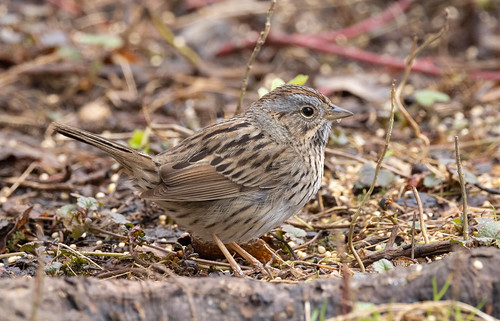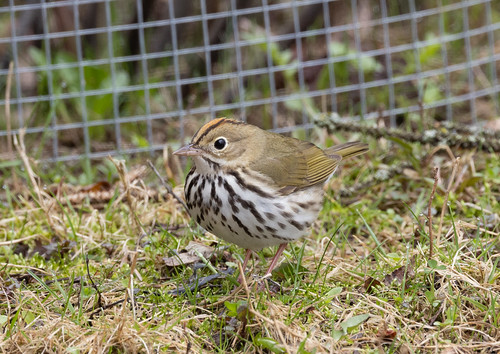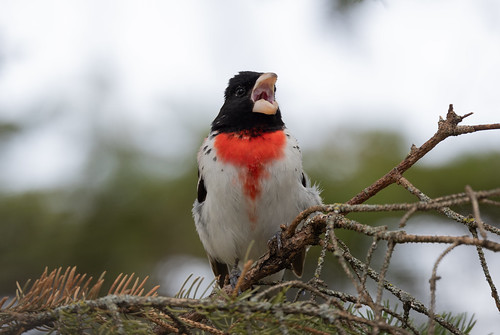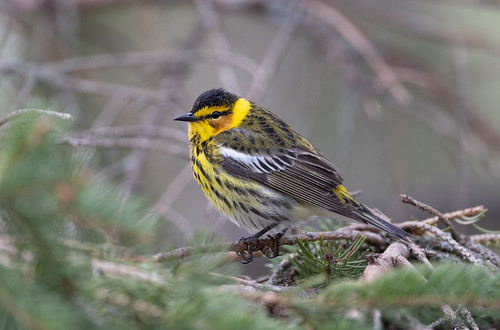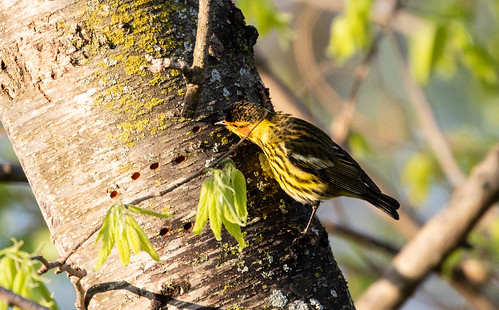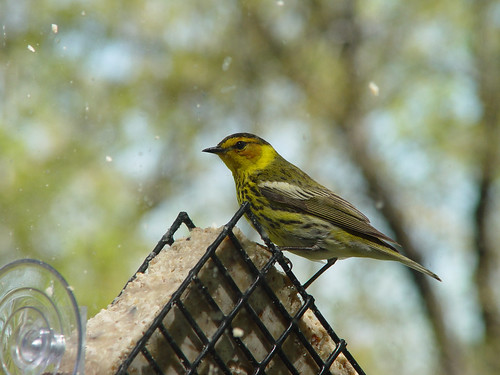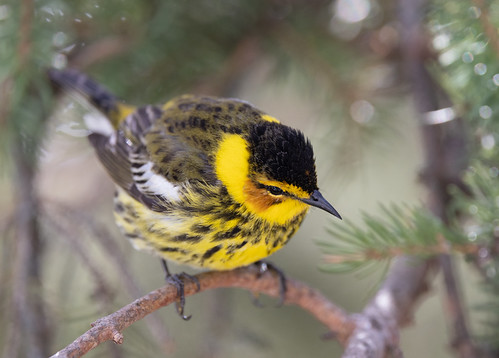This has been possibly the most glorious spring migration I have ever experienced. I’m way behind many years in the number of species I’ve seen so far this year partly because I’ve been so rooted to home first trying to avoid Covid and then sick with it. But also, thanks to the exceptionally cold April and May so far, migration is very late. Late migrants haven’t arrived in any numbers yet, but that means some earlier migrants have been staying put for a surprisingly long time in surprisingly large numbers.
Harris’s, Lincoln’s, and White-crowned Sparrows were especially persistent.
One Ovenbird showed up on May 13th and sang away just about all day every day through the 18th. He foraged along my fence close to the house for a photo op, too.
I’ve been inundated with some of the most colorful and photogenic birds of all. Rose-breasted Grosbeaks showed up on May 9—I had at least 20 on both May 13 and 14.
Scarlet Tanagers showed up on May 10 along with my first hummingbirds.
And Baltimore Orioles showed up on the 11th. Like the grosbeaks, I’ve had at least 20 on a couple of days.
I saw my first Indigo Bunting on the 14th and have seen as many as three males at a time.
But of all the colorful birds I’ve seen, my favorite has been one particular little Cape May Warbler.
Cape Mays eat insects year-round like other warblers, and on their breeding grounds they’re a specialist on spruce budworm. But during their winters in the West Indies, nectar and fruit provide 30 percent of their food intake. Indeed, their tongue has a brushier tip than other warbler tongues specifically to take in fluids more efficiently than other warblers can. Between their breeding and wintering ranges, Cape May Warblers also search for sweet food sources, and can become rather dependent on them during cold snaps when insects are harder to come by. I’ve seen individuals take over a Yellow-bellied Sapsucker’s sap wells, chasing off every other bird including the sapsucker!
Cape May Warblers are considered an economic pest by vineyard owners in Indiana, Pennsylvania, and West Virginia because they puncture grapes to drink the juice. Over the years, I’ve seen them and Tennessee Warblers doing that to the fruit in Russ’s cherry trees as well.
During their arduous spring migrations, Cape May Warblers have adapted to the human landscape by developing a search pattern for oriole and hummingbird feeders. I first discovered this in 2004 during another very cold May, when I had as many as 30 Cape Mays at a time feeding in my yard on oranges, jelly, suet, and sugar water. One even figured out how to hover at a hummingbird feeder.
This year the first Cape May Warbler I spotted in my yard, on May 19, was a female or young male coming to my window feeder.
By the 20th I had 8, and on May 21 and 22, I was up to at least a dozen—quite likely more. I have five different oriole feeders, with oranges, sugar water, and grape jelly, in different places in my yard. One adult male Cape May Warbler appropriated the one at my home office window feeder, along with a big chunk of the nearby spruce tree, for several hours on Saturday.
Cape May Warblers are tinier than chickadees, but this little guy was bound and determined to keep everyone else away from his little empire. I watched him chase other Cape May Warblers along with 15 other species. The chickadees, Red-breasted Nuthatches, starling, siskins, goldfinches, and Blue Jay were not even competition—not one of them was coming to the fruit, nectar, or jelly. And during his reign of terror, I couldn't get photos of the Blackpoll, Blackburnian, and Black-and-white Warblers in my spruce tree, even though none of them even looked at the bird feeder.
The other species were at least more realistic competitors. Hummingbirds, Tennessee Warblers, and other Cape Mays were at least in his weight category, but he also successfully drove off orioles, Rose-breasted Grosbeaks, a Gray Catbird, and my rare visiting Summer Tanager. The heaviest Cape May Warblers barely tip the scales at 15 grams—less than half an ounce, which is less than half the weight of those orioles, catbirds, and the tanager, and not even a third of what Rose-breasted Grosbeaks weigh!
I finally lost track of him after so many other Cape May Warblers arrived, with three or four coming to that feeder at once so he couldn’t possibly keep them all away. But during his brief yet tyrannical reign, this little Napoleon truly was the emperor of Peabody Street. When he reaches the end of his migration in a lovely, dark and deep spruce forest, I hope he meets up with his Josephine and they produce many tiny new despots.


